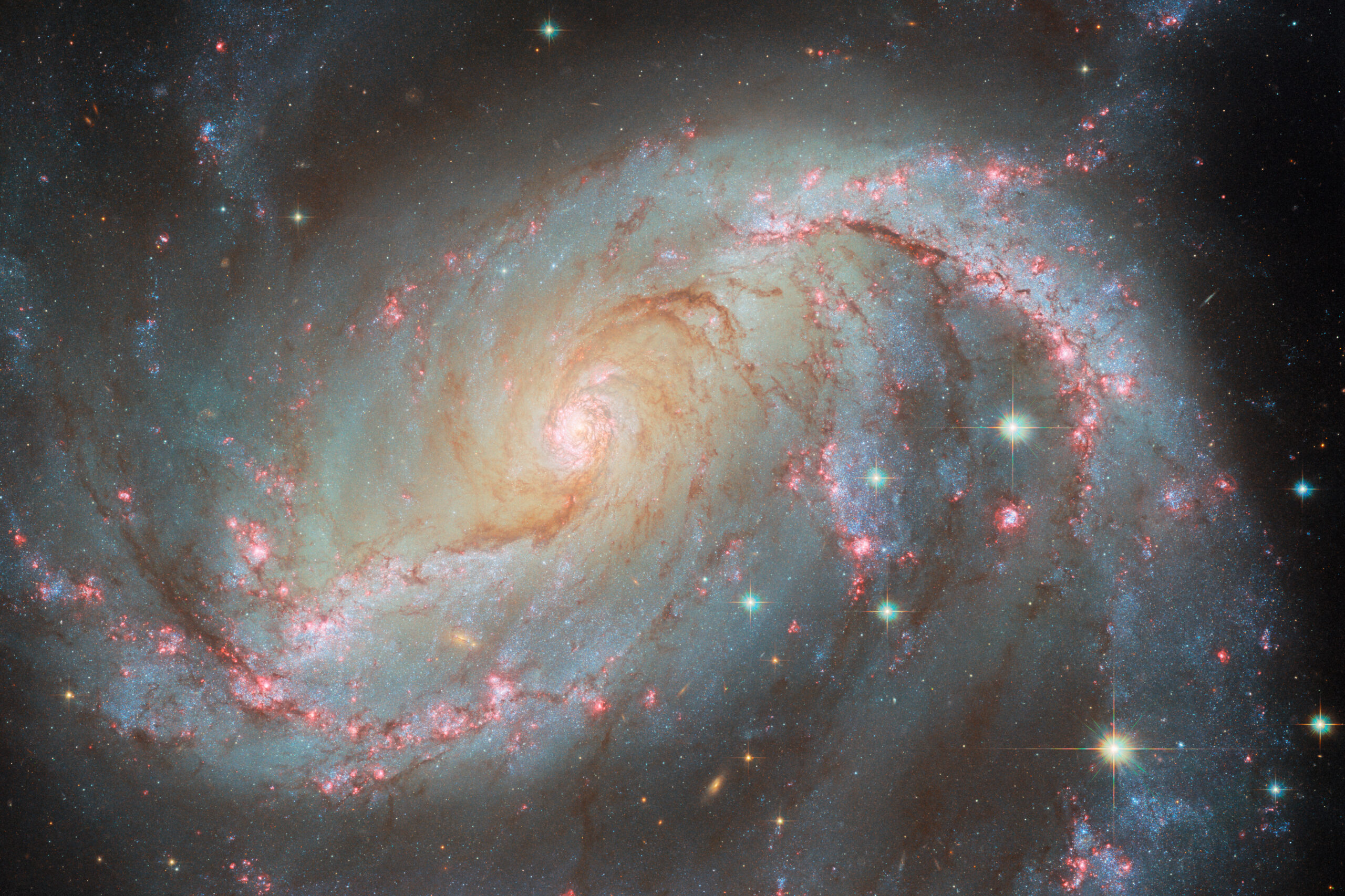NGC 1672: A Spectacular Light Show in the Universe
The universe is a vast expanse filled with wonders that capture the imagination. One of these wonders is the barred spiral galaxy known as NGC 1672, a celestial marvel that lies approximately 49 million light-years away from Earth in the constellation Dorado. This galaxy has been captured in stunning detail by the Hubble Space Telescope, a collaboration between NASA and the European Space Agency (ESA), revealing a breathtaking display of cosmic lights and phenomena.
A Closer Look at NGC 1672
NGC 1672 is not just any spiral galaxy; it’s a barred spiral galaxy, which means it has a distinctive bar-shaped structure of stars running through its center. This feature is common in about two-thirds of all spiral galaxies, including our own Milky Way. The bars are believed to be regions of intense star formation, funneling gas and dust into the central areas of the galaxy, which can fuel the growth of supermassive black holes.
The galaxy’s spiral arms are adorned with countless shining stars, creating a mesmerizing glow that is typical of spiral galaxies. These arms are also home to bubbles of hydrogen gas, which radiate a striking red light. This red glow is the result of radiation from young stars hidden within these bubbles. These infant stars are incredibly energetic, and their radiation ionizes the hydrogen gas, causing it to emit light in a process known as H-alpha emission.
The Heart of NGC 1672
At the core of NGC 1672 lies an active galactic nucleus (AGN), making it a Seyfert galaxy. Seyfert galaxies are one of the two largest groups of active galaxies and are characterized by their bright nuclei. The AGN in NGC 1672 is a powerhouse of X-ray emissions, generated by the hot, swirling matter in the accretion disk surrounding the galaxy’s supermassive black hole. The intense gravitational forces at play heat this matter to extremely high temperatures, causing it to emit X-rays.
Surrounding the AGN is a ring of hot gas and newly formed stars. These stars are not only hot but also extremely bright, contributing to the galaxy’s X-ray emissions. The interplay of these cosmic elements creates a dramatic and dynamic environment at the heart of NGC 1672, showcasing the galaxy’s multi-talented light show.
Understanding the Technical Jargon
For those not familiar with astronomical terms, let’s break down some of the technical jargon in simpler terms:
- Barred Spiral Galaxy: A type of galaxy that features a central bar-shaped structure composed of stars. This bar is thought to influence the motion of stars and gas within the galaxy.
- Hydrogen Gas Bubbles: Regions within galaxies where young stars emit radiation that ionizes surrounding hydrogen gas, causing it to glow in the visible spectrum, usually in red.
- Active Galactic Nucleus (AGN): The central region of a galaxy that is exceptionally bright, often due to the presence of a supermassive black hole consuming material and emitting energy.
- Accretion Disk: A structure formed by diffused material in orbital motion around a central body, such as a black hole. The material heats up and emits radiation as it spirals inward.
The Significance of Hubble’s Observations
The Hubble Space Telescope’s observations of NGC 1672 provide valuable insights into the processes that govern galaxy formation and evolution. By studying galaxies like NGC 1672, astronomers can better understand the life cycle of stars, the dynamics of galactic structures, and the role of supermassive black holes in shaping their host galaxies.
Hubble’s ability to capture images across different wavelengths of light allows scientists to study various components of galaxies, from the stars and gas in their disks to the energetic phenomena occurring in their cores. These observations are crucial for unraveling the mysteries of the universe and piecing together the cosmic puzzle.
Additional Insights and Reactions
The discovery and study of NGC 1672 have sparked interest and excitement within the astronomical community. Researchers are particularly fascinated by the galaxy’s active nucleus and the processes driving its intense X-ray emissions. The detailed images captured by Hubble offer a unique opportunity to study the interactions between the galaxy’s bar, spiral arms, and central black hole.
The study of barred spiral galaxies like NGC 1672 also has implications for understanding the evolution of our own Milky Way galaxy. By comparing different barred spiral galaxies, scientists can gain insights into the various stages of galactic evolution and the factors that influence their development.
Good to Know Information
- Seyfert Galaxies: Named after Carl Seyfert, an American astronomer who first identified this class of galaxies in the 1940s. They are characterized by their bright nuclei and strong emission lines.
- H-alpha Emission: A specific red light emitted by hydrogen gas, often used by astronomers to identify regions of active star formation in galaxies.
- Constellation Dorado: Located in the southern sky, Dorado is home to several interesting astronomical objects, including the Large Magellanic Cloud, a satellite galaxy of the Milky Way.
Conclusion
The Hubble Space Telescope’s image of NGC 1672 offers a captivating glimpse into the intricate and dynamic nature of galaxies. By studying this barred spiral galaxy, astronomers are uncovering the secrets of star formation, galactic dynamics, and the powerful forces at work in the universe. As our understanding of galaxies like NGC 1672 deepens, so too does our appreciation for the complexity and beauty of the cosmos.
For those interested in exploring more about this fascinating galaxy, additional images and information can be found on the official NASA website here.
For more Information, Refer to this article.






























